| The World Bank Group. Global Development Finance
1998 Commercial bank loan syndications
Loan commitments increased to $133 billion in 1997
(figure A5.8). While commitments slowed in the last two months of the year owing to
the spread of the East Asian financial crisis, the crisis had less impact on developing
countries’ access to the loan market than on their access to bond markets, in part
because of the greater use of securitized lending. Loan commitments totaled $10 billion
during the last two months of the year, down more than 22 percent from the monthly rate
through October.
Short-term borrowing
Short-term borrowing increased from about 15 percent of the total
volume in 1996 to about 20 percent in 1997. The increase was due largely to new entrants
from Europe and Central Asia, many of which could contract funds only for short durations,
and to a shift to short-term borrowing from East Asia and the Pacific as the crisis hit in
the second half of the year.
Regional composition
Syndicated loan commitments to East Asia and the Pacific fell
from $41 billion in 1996 to $39 billion in 1997, as lending to Thailand fell in the first
half of the year and lending to Indonesia, the Philippines, and Malaysia plummeted with
the onset of the crisis (figure A5.9). While borrowers in the region could still
access the loan market in the third quarter (when volumes were about equal to the
second-quarter level), the last quarter saw a sharp fall in loan commitments. Strong
lending to Indonesia in the first half of the year made it the leading borrower from the
region for the year as a whole, followed by China. Private sector borrowers accounted for
more than 70 percent of the regional syndications, with most of the rest going to the
nonsovereign public sector in China (figure A5.10). Though short-term borrowing
increased in the second half of the year, the average maturity for the year was still
about 4.5 years.
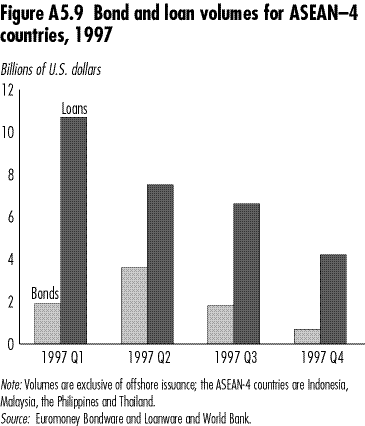
Back to top
Back to Contents
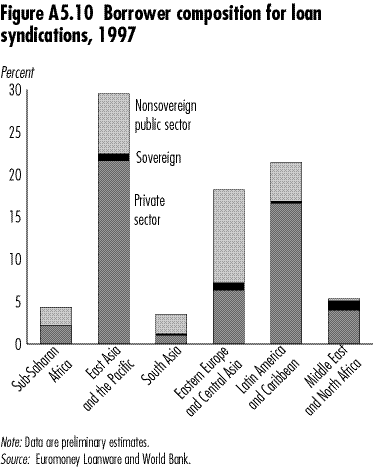
Loan commitments to South Asia fell to $6 billion in 1997,
about 20 percent lower than the year before, due primarily to a drop in syndications for
Pakistan. The volume for India increased marginally. Sub-Saharan Africa registered
marginal growth in its syndications. South Africa accounted for three-fourths of the
total, with an average maturity of 2.5 years. Small quantities of short-term
financing were put together for C˘te d’Ivoire, Ghana, Namibia, Senegal, Zambia, and
Zimbabwe.
Syndicated loan commitments to Europe and Central Asia rose
to $28 billion in 1997, 85 percent higher than in 1996, owing largely to increased lending
to Croatia, Poland, Russia, and Slovakia. In contrast to other regions activity picked up
as the year came to a close, with $8 billion raised in the last quarter. About 60 percent
of the funds were raised by the nonsovereign public sector. Volumes fell 40 percent for
Hungary and increased marginally for Turkey. The average maturity of loans was a little
less than 4 years.
Back to top
Back to Contents
Syndicated loan commitments to Latin America and the Caribbean
rose to $42 billion, 70 percent greater than in 1996, as commitments to Brazil
more than tripled to pass $12 billion. The $10 billion in commitments to Mexico was the
region’s second largest after Brazil. Commitments for Argentina declined but were
still around $7 billion. Over 95 percent of the capital went to the private and
nonsovereign public sector, which borrowed funds with an average maturity of about
4.5 years. Government borrowing from the region was restricted to Argentina,
Colombia, and Panama.
Syndications for the Middle East and North Africa surged
past $9 billion in 1996 and then past $11 billion in 1997, due primarily to Saudi Arabia
and Oman, which accounted for almost three-fourths of the regional volume. Egypt and
Morocco returned to the loan market after being absent the year before. Most of the funds
were arranged for the private sector.
Comparing the bond and syndicated loan markets
Developing countries have typically relied more on loan
syndications than on bond issues. For example, bond issues averaged $38 billion from 1993
to 1995, while loan volumes averaged $75 billion (figure A5.11). The main
reasons were that bond investors lacked information about many developing country
borrowers and few developing countries had a high enough credit rating to enable
institutional investors to purchase their bonds. By contrast, many commercial banks have
established relationships with developing country borrowers (for example, in the course of
financing short-term trade facilities) that enable them to expand their loans, and banks
are typically less constrained in lending to unrated or speculatively rated borrowers than
are many bond investors.
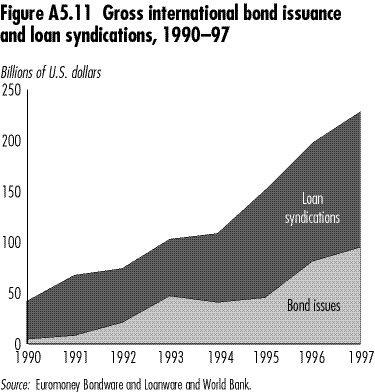
In recent years, however, this gap has been narrowed by the rise
in bond issues, as more developing countries earned investment-grade ratings (20 had done
so before the onset of the East Asian crisis) and market familiarity with developing
countries increased. Thus in 1996–97 bond issues averaged $85 billion, while loan
volumes averaged $115 billion. The East Asian crisis has probably interrupted this trend,
since bond market access has been substantially reduced (and several countries’
ratings have been downgraded), while many countries can still tap the loan market. If
there is a rapid recovery from the crisis, however, the relative increase in bond issues
may continue owing to the potentially larger investor base in the bond market and the
greater flexibility of bond instruments in managing developing country exposure (for
example, through the use of put and call options). On the other hand, syndicated financing
can more easily accommodate individual deals that are heavily tailored to the requirements
of the borrower.
Portfolio equity
flows
International placements of equity issues rose from $12.5 billion
in 1996 to $18 billion in 1997, while foreign investments in domestic stock markets fell
from $33 billion to $14 billion (figure A5.12 and table A5.1). Over 85
percent of international placements were brought to the market before the spread of the
East Asian crisis in late October. Developing countries’ share in global
international equity issues rose from about 15 percent in 1996 to about 25 percent in
1997. Equity placements through privatizations accounted for about 10 percent, and much of
the remainder flowed through initial public offerings targeted to international investors.
Though developing country participation in international equity markets and foreign
investment in domestic markets in developing countries have increased, the flows remain
concentrated in a small group of countries.
Back to top
Back to Contents
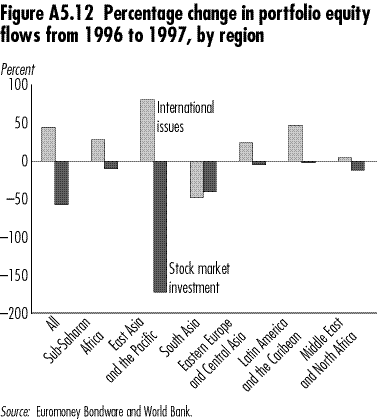
International equity issues from East Asia and the Pacific jumped
to $8.5 billion in 1997, from $4.7 billion in 1996, owing largely to $7.5 billion in
issues from China. Volumes from other East Asian countries fell, accompanied by reports of
postponements and cancellations of highly rated issues due to the deterioration in market
conditions. Issues from Indonesia, Malaysia, the Philippines, and Thailand almost
disappeared after July. Direct investments in regional stock markets fell to –$7
billion (from $10 billion in 1996), with all of the major countries except China believed
to have recorded outflows in the second half of the year.
International equity placements from South Asia fell by
half, as issues from India dropped from $1.3 billion in 1996 to $0.6 billion in 1997.
Investments in the region’s stock markets are estimated to have declined due to
political uncertainties in India. Stock markets in Pakistan and Sri Lanka rose by more
than 20 percent for the year as a whole.
Portfolio flows to Europe and Central Asia rose marginally
to $9 billion in 1997. The increase in international equity issues was offset by a fall in
direct investments in local stock markets. Over 90 percent of the primary market issues
were in the form of global depository shares and American depository shares from Hungary,
Poland, Turkey, and Russia. Hungary ($700 million) and Poland ($600 million) had the
largest equity issues from the region, with major activity related to issuance of global
depository receipts. Other major offerings came from Egypt, Kazakhstan, and Slovenia.
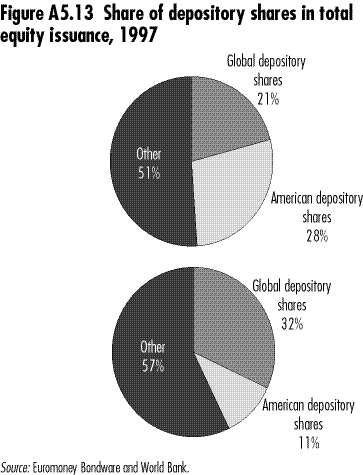
Back to top
Back to Contents
Portfolio equity flows to Latin America and the Caribbean rose
to $16 billion in 1997 from $14 billion in 1996, as international equity issuance
increased by almost 50 percent, to an estimated $5.5 billion. International equity
issues out of Argentina were four times higher in 1997 than in 1996, while those from
Brazil were six times higher. Brazil accounted for more than 45 percent of total issues,
with the largest ($1.2 billion) regional equity placement coming from a private
sector Brazilian bank. The IFC’s index of Latin American stock markets increased by
38 percent during the first six months of the year, when investments in local stock
markets surged. However, market conditions deteriorated with the spillover of the East
Asian financial crisis late in the year. From September to December the IFC index fell 12
percent, international equity issues fell more than 60 percent, and some markets
(particularly Brazil) saw outflows of foreign investments.
Equity flows to Sub-Saharan Africa and the Middle East
and North Africa remained at approximately the same levels as in 1996. South Africa,
the only Sub-Saharan African country placing equities in international markets, issued
almost $1 billion in 1997, up from $0.6 billion in 1996. Investments in regional
stock markets as a whole are estimated to have declined by 13 percent in 1997.
International equity issues from the Middle East and North Africa equaled $0.4 billion,
about the same as in 1996, all of it accounted for by global depository shares from Egypt
and Lebanon. However, investments in local stock markets declined to $1 billion in 1997,
from $1.2 billion in 1996.
Recent initiatives in emerging equity markets
There have been major efforts over the past two years to
strengthen emerging equity markets by broadening the range of securities in primary and
secondary markets, improving clearance and settlement, and increasing conformance to
international regulatory practices in taxation, securities lending norms, and other rules
and regulations governing securities markets. The following are brief illustrative
summaries of some of the initiatives undertaken in these areas:
In Argentina an independent clearinghouse, Argenclear, is
being established that will benefit settlements and securities administration. Delivery
against payment will apply for all trades executed on the national securities market.
Trading in Central European securities will benefit from the
establishment by the OTOB—the derivatives section of the Vienna Stock Exchange in Austria—of
a new derivative product line based on the indexes of Central and Eastern European markets
(the CECE indexes derivatives).
The Brazilian Central Bank and the Brazilian Monetary
Council will allow registered foreign investors to hedge their exposure through
derivatives trading on the Brazilian stock exchanges, futures exchanges, and registered
over the counter markets.
Hungary is improving the infrastructure for settlement and
securities administration, including the establishment of an integrated on-line system for
futures and options clearing, settlement, and risk management.
The Securities and Exchange Board of India (SEBI) has set
up a committee to prescribe a regulatory format for derivatives trading, and the National
Stock Exchange began trading in dematerialized shares in December 1996. The Bombay Stock
Exchange has proposed the establishment of a depository, and SEBI has allowed shares to be
borrowed to facilitate settlement. SEBI also is considering measures to simplify
procedures and to improve registration and investment by foreign institutional investors.
The Reserve Bank announced guidelines enabling foreign institutional investors to purchase
central and state government bonds, except for Treasury bills. A self-regulatory
organization has been formed—the Indian Association of Securities
Intermediaries—to regulate securities market intermediaries.
Back to top
Back to Contents
In April 1997 the Indonesian Capital Market Supervisory
Board issued a decree setting requirements for margin trading services by stock exchange
members. Another decree clarifies the permissible corporate actions for custodians of
securities.
Notable progress has been achieved in the clearance, settlement,
and depository facilities in Malaysia. All listed equity issues on the Kuala Lumpur
Stock Exchange have been immobilized in the Central Depository System. At present delivery
is within five days of the trade and payment within seven. The Securities Commission
authorized 15 brokerage houses to engage in securities borrowing and lending
activities. Foreign companies can now apply to have their shares listed on the Kuala
Lumpur Exchange provided that they meet the guidelines for such listing.
Mexico’s achievements in pursuing effective
securities administration are well known. Delivery against payment settlement is carried
out by applying gross settlement of securities and cash netting; it includes financial
safeguards supported by collateralized lines of credit that eliminate the principal risk
in the settlement process and reduce the need to use cash and credit. S.D. Indeval
centralized the custody and settlement of all instruments negotiated in the Mexican market
(banking, government, corporate debt, and equities) in April 1997. A real-time connection
has been established between this system and the central bank payment system. In January
1997 S.D. Indeval launched an electronic securities lending system.
Peru is implementing a valuation system for fixed-income
instruments and revisions to the Electronic Trading System (ELEX) to provide greater
flexibility and ease of trading and to offer real-time access to information on trades. A
December 1996 amendment to the income tax law provides tax exemptions on income from debt
obligations issued by investment funds, trust equities of securitization companies, or
corporations. Also, a new securities market law is designed to improve settlements and
securities administration (for example, by separating the clearing and settlement services
from the book-entry registry).
In Thailand the trading of Thai Trust Fund shares began in
June 1997. The fund acts as a nominee for foreign investors, which enables them to avoid
the 49 percent limit on foreign ownership of Thai companies.
The Istanbul Stock Exchange in Turkey established an
international market to provide an investment environment similar to that in industrial
economies. Intermediary institutions will be closely controlled, and public disclosure
requirements will be fully implemented.
International clearing organizations are also active in
the development of emerging markets. In the euromarket, the Philippine peso became the
38th settlement currency at Cedel Bank. Cedel Bank’s Global Credit Support Service is
a book-entry real-time collateral management service launched in September 1996.
International organizations continue to provide guidance
to market participants on best practices. The Committee on Payment and Settlement Systems
of the central banks of the G-10 countries and the International Organization of
Securities Commissions have focused on mitigating the systemic risks associated with
settlement systems. The recently released report “Disclosure Framework for Securities
Settlement Systems” addressed the issue through enhanced transparency of clearance
and settlement systems. Other published documents address real-time
gross-settlement-systems and clearing arrangements for exchange-traded derivatives. The
central securities depositories of 13 E.U. countries have formed the European Central
Securities Depositories Association. Its objectives are to develop and improve links
between European national central depositories, to identify and study projects of mutual
interest, and to make recommendations for the benefit of all European national central
depositories.
Note
1. The decline in secondary market spreads through September
1997 and their subsequent rise with the East Asian financial crisis is covered in some
detail in chapter 1.
Back to top
Back to Contents |